LABELS |
CLASS |
SUBSTANCES |
EXAMPLES/ UN No. |
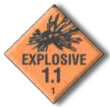 |
1.1 |
Substances & Articles which have a mass explosion hazard |
UN 0076
Dinitrophenol 1.1D |
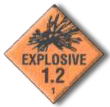 |
1.2 |
Substances & Articles which have a projection hazard but not a mass explosion hazard. |
UN 0328
Cartridges for weapons, inert projectile 1.2C |
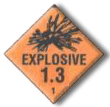 |
1.3 |
Substances & Articles which have a fire hazard and either a minor blast hazard or a minor projection hazard or both, but not a mass explosion hazard. |
UN 0247 Ammunition, incendiary 1.3J |
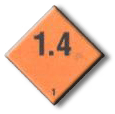 |
1.4 |
Substances & Articles which present no significant hazard. |
UN 0337 Fireworks 1.4S (Pyrotechnic articles designed for entertainment) |
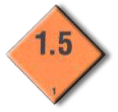 |
1.5 |
Very insensitive substances which have a mass explosion hazard. |
UN 0482 Substances, explosive, very insensitive 1.5D |
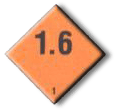 |
1.6 |
Extremely insensitive articles which do not have a mass explosion hazard. |
UN 0486 Articles, explosive, extremely insensitive 1.6N |
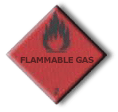 |
2.1 |
Flammable gases |
UN 1001 Acetylene, dissolved Heating will cause a pressure rise with risk of bursting, explosion and fire. |
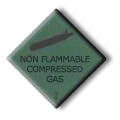 |
2.2 |
Non-flammable,
non-toxic gases |
UN 1066 Nitrogen, compressed Heating will cause a pressure rise with the risk of bursting. |
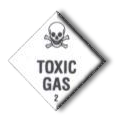 |
2.3 |
Toxic gasses |
UN1017 Chlorine Heating will cause a pressure rise with risk of bursting and toxic. |
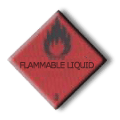 |
3.1
3.2
3.3 |
Flammable liquids, division into groups according to flashpoint from -18° to +61° C. |
3.1 1090 Acetone Flp. = .20°C
3.2 1294 Toluene Flp. = +7°C
3.3 1263 Paint Flp. = +32°C
Risk of fire and explosion by escape from gases |
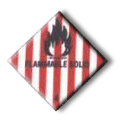 |
4.1 |
Flammable Solids |
UN 1338 Phosphorus, Red risk of fire. |
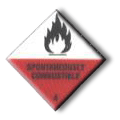 |
4.2 |
Spontaneously combustible |
UN1384 Sodium Dithionite Risk of fire. React violently in contact with water |
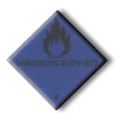 |
4.3 |
Dangerous when wet |
UN1402 Calcium carbide. React violently in contact with water |
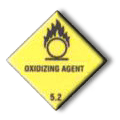 |
5.1 |
Oxidizing substances |
UN 1456 Calcium Permanganate. Substances promote combustion |
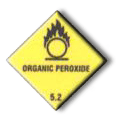 |
5.2 |
Organic peroxides |
UN3106 Organic peroxide, Type D, solid Dibenzoyl Peroxide, Risk of explosion and fire ; protection for intensive warming, shock and friction. |
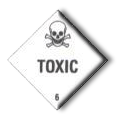 |
6.1 |
Toxic substances |
UN1547 Aniline. Toxic if swallowed, by skin contact or by inhalation. |
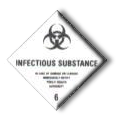 |
6.2 |
Infectious substances |
UN3291 Clinical waste, unspecified, high community risk are micro organisms that cause severe human or animal disease. |
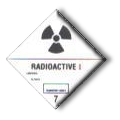 |
7 |
Radioactive materials,
cat. I
|
UN2981 Uranyl Nitrate, solid Schedule 5 |
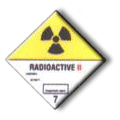 |
7 |
Radioactive materials,
cat. II
|
UN 2976 Thorium Nitrate, solid Schedule 6 |
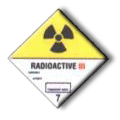 |
7 |
Radioactive materials,
cat. III
|
UN2979 Uranium Metal, pyrophoric Schedule 10 |
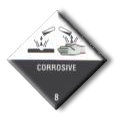 |
8 |
Corrosives |
UN 1779 Formic Acid. Contact with a relatively small quantity of water creates violent reaction and other dangerous substances |
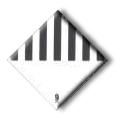 |
9 |
Miscellaneous dangerous substances and articles |
UN 2211 Polymeric Beads, expandable; Risk of fire. Inhalation of harmful substances. In risk of fire formation of extreme toxic or water pollutant. |
 |
|
Marine Pollutant , MP |
Marine pollutants are regulated of the requirements by IMO. The marine pollutant mark should be placed adjacent of the dangerous goods label. |
 |
|
Fumigation warning sign |
Marking of units which are carried under fumigation. Warning signs are fitted on the container door. Do not enter this cargo unit. |
|